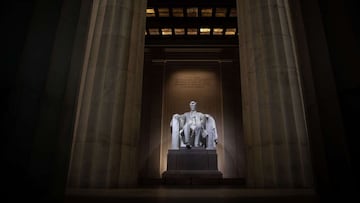What's the difference between a popular vote and electoral college vote?
The Electoral College skews the numbers, it even affects the promises candidates make. How would a popular vote change the landscape of US elections?

The Electoral College doesn't reflect the popular vote in US presidential elections. Four time, presidential candidates have won the national popular vote but been denied the presidency. Here’s how.
Follow the live coverage of the US Election 2020 results
What is the Electoral College?
The Electoral College isn’t actually a place. It’s a process that was created in 1787 as a compromise between the election of a president by members of Congress and the election of a president by qualified citizens, and according to the Brennan Center for Justice in part because the Founding Fathers were uncomfortable with giving power to the people.
The Electoral College was engineered to empower the white south in times of slavery. Today, it is still seen as a flawed system; contrary to the ‘one person, one vote’ principle of democracy.
How does the Electoral College work?
The Electoral College has 538 members. To be elected president, a candidate must win at least half plus one; or 270 electoral votes.
We may be headed to another divergent election.
— NationalPopularVote (@NatlPopularVote) September 29, 2020
Regardless of which candidate you support, isn't it time we do away with this uncertainty and strengthen the vitality of American democracy? https://t.co/ZsuxqkYDzX
Each state is awarded the same number of college "electors" as it has representatives in Congress, or the House and the Senate combined. Every state has two votes for its Senators plus a number of votes equal to the number of its Congressional districts. These two Senate additional votes effectively triple the voting power of the smallest states, while having only a negligible impact on the voting power of large states.
Following an election, the electors vote for the presidential candidate; guided by the winning popular vote across the state. This year the electoral college electors' vote will take place on December 14. So when you vote in a general election you are in fact voting for your candidate’s preferred electors.
All states apart from Maine and Nebraska have a ‘winner-take-all’ policy where the state looks only at the overall winner of the state-wide popular vote, as opposed to proportional representation.
How does the popular or electoral vote affect elections?
In the 2016 election Hillary Clinton won the popular vote, nearly 3 million more votes nationally than Donald Trump, but because Trump secured 77 more electors than Clinton, in part due to narrow Trump victories in Michigan, Pennsylvania, and Wisconsin (in total 77,744 votes), he still won the presidency.
The reason this was possible is that the number of Electoral College members match the number of state’s members of congress, and these aren't representative. The number of congressmen assigned to each state in the House of Representatives hasn’t changed for over a century, so that today there are is one voting member for every 747,000 Americans; more than triple the original ratio.
However, this elector-to-voter ratio is an average. The real flaw in the system is that it varies wildly from state-to-state. Meaning that individual voters in some states hold a huge amount more real power than others. Voters in Wyoming have nearly four times as much influence as Californians do, for instance.
An example; Montana’s 1,050,493 people have just one House member but Rhode Island, a state with only 9,000 more residents is tipped into the bracket of having two House representatives, which is one for every 529,820 citizen. Suddenly every resident in Rhode Island has almost double the power compared to someone living in Montana.
In the most extreme case, npr reported that it would be possible to win a presidential election with just 23 per cent of the popular vote.
Voters living in states where the majority don’t agree with them end up feeling leads to voter disillusioned and sometimes even abstain from voting.
Voting in US Election 2020
In 2020, this skewed system has been wholeheartedly shaping the nature of the campaigns. In the first four weeks of campaigning, candidates focused attention on only 10 closely divided battleground states during while ignoring 40 states, according to Fair Vote analysis.
nah fam it just shows we dont live in a swing state aka our electoral college is 100% gonna vote either red or blue, and thus our vote doesnt count. so miss me with that elitist shit
— BussyMane (@BussyMane) September 27, 2020
source: i live in Mississippi, but pls tell me how my vote counts in this deep red state
Key battleground states this year include Florida, Wisconsin, Pennsylvania, Michigan, Arizona, North Carolina, Georgia, Ohio and Iowa.
Republicans at an advantage over Democrats
It’s been suggested that Republicans are far more likely to benefit from this imbalance in the electoral process than Democrats.
According to a Texas University study in 2019, 'inversions' (where a candidate wins the election without winning the popular vote) can be expected in more than 30% of elections, generally. But Republicans should be expected to win 65% of Presidential contests in which they narrowly lose the popular vote.
The process of elector selection naturally gives more weight to lightly populated states where Republicans excel. What's more, report Slate, the winner-take-all system that most states use to award electors also leads Democrats to waste a lot of votes running up the score in big states like California, while losing in small states.
This means that an electoral overhaul in favour of the popular vote could tip the balance in favour of Democrats, in a way previously unseen in US politics.
Could the popular vote decide a US election?
It would take a constitutional amendment to dissolve the Electoral College; but considering how difficult it is to pass constitutional changes, this is highly unlikely to happen. However, there’s a separate movement, growing in popularity that involves states individually signing up to an agreement that eventually could lead to the same outcome.
The National Popular Vote Interstate Compact (NPVIC) is an agreement that emerged in 2006 among a group of US states to award all of their Electoral College votes to whichever presidential candidate wins the popular vote nationally, as opposed to in the state. The compact is designed to ensure that the candidate who receives the most votes nationwide is elected president.
Related stories
It is currently not active and would come into effect only when it could guarantee that outcome; only when states with a majority of the electoral votes have joined the compact.
Current members of the NPVIC include California, Washington, Connecticut, New York and Illinois. Right now in 2020, 15 states have already joined the compact, amounting to a total of 196 Electoral College votes. 74 additional Electoral College votes are needed to give the compact a majority and bring it into force.
Want to abolish the Electoral College? Easier than you might think.
— Andrea Phillips (@andrhia) September 25, 2020
The National Popular Vote Compact has 195 electoral votes NOW, and states holding another 64 are already considering it. PA, OH, NH, VA, SC, FL: write your state legislators!


